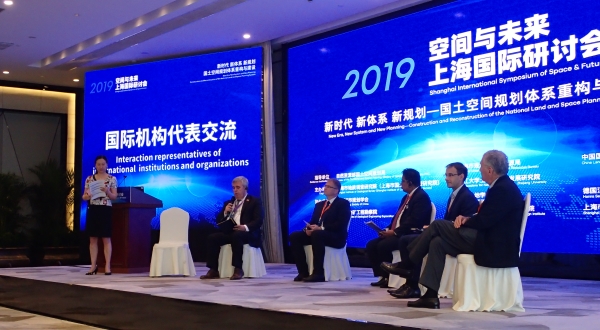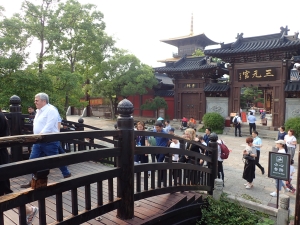

News in 2019
|

FIG Vice President Orhan Ercan speaking at the Conference on the FIG
perception on the relationship between Spatial planning and SDGs in 2030
Agenda and what is your suggestion on Chinese Spatial planning system
“Shanghai International Symposium of Space & Future Conference” was held on 14 - 15 June 2019 at Golden Tulip Hotel Shanghai. The conference was directed by the Bureau of Territorial and Spatial Planning, the Ministry of Natural Resources of the PRC, the Shanghai Urban Planning and Natural Resources Bureau and the China Land Surveying and Planning Institute.
On behalf of FIG, vice-president Orhan Ercan and commission 8 chair Marije Louwsma, attended the event initiated by China Land Surveying and Planning Institute, Shanghai Urban Planning and Natural Resources Bureau and Ministry of Natural Resources. The event is part of the activities of working group 8.1 about rural-urban interdependencies led by Rosy Liao (China Land Surveying and Planning Institute) and Michael Klaus (Hans Seidel Foundation).
The conference included the Global Land Tenure Network - UN Habitat, Hanns Siedel Stiftung; the International Federation of Surveyors - FIG; The International Society of City and Regional Planners (ISOCARP); The Observatory of Transport Policy and Strategies in Europa; The Government of Lower Bavaria; Infrastructure, Transport and Tourism - Japan, Ministry of Interior and Kingdom Relations - The Netherlands participated and supported as international organizations and institutions.
Spatial planning means planning with uncertainty, imposed by for example climate change and advancing technologies. A traditional planning approach as applied in many industrialised countries is not sufficient, and therefore, a new paradigm for planning was developed in China. The new paradigm focuses on an eco-oriented pathway, hi-speed development and high-quality living standards for the people. We have seen many examples of planning practice in China, at the national level as well as the regional and local level. Also, several international examples of planning, e.g. from Germany, the Netherlands, and Japan were presented and discussed. In the afternoon, three parallel sessions were focusing respectively on regional planning – in particular water related planning issues along Yangtze River Economic Belt -, city renewal and rural areas rejuvenation.
The need for and emphasis on a paradigm shift towards sustainable development, by embedding for example natural resources in the planning system, was repeated multiple times. How this best can be implemented in practice was subject of discussion, and various international viewpoints and practices were exchanged.
The motto of the conference was "New Era, New System and New Planning - Building a Sound and Better Territorial and Spatial Planning”. The conference was held in two parallel sessions.
On the first day of the conference; shortly after the opening speeches and Experts Presentations sessions, a panel session on "Interaction pepresentatives of International Organizations and Institutions" was moderated by the Ministry. Representatives of international professional organizations attended this panel as speakers and enlightened the audience within the scope of moderator questions. Panel speakers;
The moderator asked Mr Orhan Ercan: "What is your perception on the relationship between Spatial planning and SDGs in 2030 Agenda and what is your suggestion on Chinese Spatial planning system " and gave 5 minutes for the reply. The speech by Orhan Ercan in response to this question is given below./p>
Participation in such meetings; meeting the public institutions and
organizations, academicians and the private sector in the host country,
discussing professional issues and exchanging information is extremely
important in order to understand the professional eco system of the
country in this way. As a result of these participations and
discussions, it is very useful to inform them about our federation which
is the umbrella organization of our profession and to ensure their
interest and participation in our Task Forces, Commission Works etc.
In this context, our participation in the conference and the sharing of
our experiences have been extremely beneficial for both Shanghai
professional participants and FIG.
The second day the floor was given to young experts and their view on spatial planning, for both urban and rural development in the new era of spatial planning in China. Issues addressed were among others management of natural resources in general, increasing greenspace in cities, improving ecological space, land consolidation and quality of life.
The afternoon field trip to the Guangfulin Ancient Cultural Site and pit hotel showed us respectively how a heritage site was developed into a tourist destination and how an excavation pit was transformed into a hotel. The pit of a former stone quarry now houses a hotel with 2 floors above the ground and 17 floors in the pit. Construction started in 2013 after the quarrying site was closed. It is a good example of how former excavation sites can be transformed by giving it another destination. Based on archaeological excavations, the cultural heritage site of Guangfulin was developed to show how society at this location evolved over the last 5500 year. The site now encompasses a culture exhibition area, leisure resort area and various facilities.
 About 400 professionals and academicians from 46 institutions
from China participated in the conference. |
 The field trip to the Guangfulin Ancient Cultural Site and pit hotel showed us respectively how a heritage site was developed into a tourist destination |
I have to express that as International Federation of Surveyors, we are very happy to be here together with you.
UN member states are committed to use the goals to frame their agenda and policies over the next 15 years (2016-2030). The goals and targets integrate economic, social and environmental aspects and recognize their interlinkages in achieving sustainable development in all its dimensions. Targets are defined as global targets, each government will set their own national targets guided by the global level of ambition, but taking into account national circumstances. Many of the SDGs will not be achieved without the global land governance, administration and management issues being resolved at scale.
Solutions to the overall global land issues relate to alleviation of:
A Task Force has been established by FIG on adapting Sustainable Development Goals and Targets to our profession. We look forward to the participation and contribution of all member associations.
The central focus of spatial planning is on judgement of adequate locations for economic and social functions in geographical and physical settings. Therefore, spatial planning is immediately associated with economic planning, social and cultural planning of human activities along with environmental and ecological planning.
National planning, regional planning, metropolitan planning, urban planning and rural planning are hierarchically formalized spatial planning components. All of these planning approaches rely on meeting the requirements of three essential principles. These are “rationality”, “sustainability” “functionality” principles in decision making and planning processes.
There is no doubt that for fulfillment of seventeen sustainable development goals, the spatial planning will play pivotal role due to its interdisciplinary nature. Success in achieving global sustainable development is determined by the magnitude of considerations pertaining to location and spatial aspects in decisions and actions. Location and spatial aspects “stand right in the heart of the sustainability” graphic denoted by joint coincidences of three overlapped sectors named «ECONOMY, SOCIETY AND ECOLOGY»
This fact alone emphasizes the vital relevance of spatial planning for sustainable development goals. 8 out of 17 SDG’s directly related with spatial planning.
I would like to conclude my speech with a contribution to our Chinese colleagues;
Orhan Ercan, FIG VIce President and Marije Louwsma, Chair of FIG Commission 8 - Spatial planning and development
July 2019